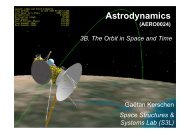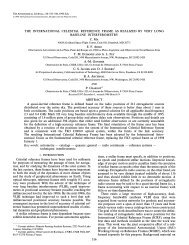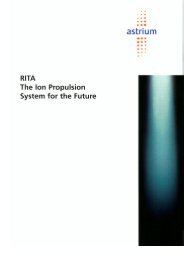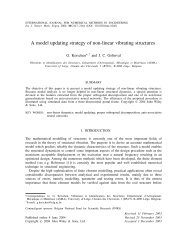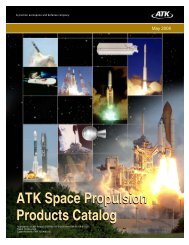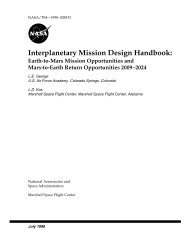CASSINI MANEUVER EXPERIENCE: FINISHING INNER CRUISE
CASSINI MANEUVER EXPERIENCE: FINISHING INNER CRUISE
CASSINI MANEUVER EXPERIENCE: FINISHING INNER CRUISE
Create successful ePaper yourself
Turn your PDF publications into a flip-book with our unique Google optimized e-Paper software.
Results<br />
The primary result of this analysis is a recommendation<br />
for Gates model parameters that more accurately represent<br />
maneuver execution errors using current maneuver modeling.<br />
These Gates model parameters will be used to update statistics<br />
for future maneuvers and for studying navigation strategies<br />
during the tour.<br />
The secondary result is an estimate of how much<br />
improvement can be gained in execution errors by refining<br />
maneuver modeling. Obviously, this requires either some<br />
conjecture. These speculative assumptions include the<br />
following:<br />
the DSM magnitude error does not represent typical<br />
performance,<br />
the TCM-6 pointing error does not represent typical<br />
performance,<br />
the magnitude errors contain a -0.095% bias, and<br />
the pointing errors contain a 1.7 mrad bias along the<br />
+Y pointing-plane axis.<br />
The first two assumptions must be accepted in order to<br />
consider the latter two. However, all four speculations lead to<br />
considerable analysis before they can be resolved. No model<br />
has been found that might explain why the DSM was the only<br />
overburn to date. On the other, given that the DSM execution<br />
error is atypical, the -0.095% bias merely represents an error<br />
in the scale factor for the on-board accelerometer.<br />
The TCM-6 pointing error is very suspiciously<br />
correlated with the main engine pre-aim setting. Figure 10<br />
shows the history of main engine pre-aim settings. The<br />
feature of interest here is the TCM-6 setting, which is quite<br />
different from the other settings. It does not take a great leap<br />
of imagination to propose models of how the main engine preaim<br />
setting affects pointing errors in such a way to explain<br />
away the TCM-6 pointing error. On the other hand, no<br />
analysis has been performed to support any such model and so<br />
the relationship between the TCM-6 pre-aim setting and the<br />
pointing error remains speculation.<br />
A pointing error bias along the +Y pointing-plane axis,<br />
which is nearly parallel to the Y, axis in Figure 3, is even<br />
more difficult to explain. Although not shown here, the<br />
AACS estimates also indicate such a bias. One is then lead to<br />
speculate that this 1.7 mrad bias is related to the attitude<br />
control system.<br />
this, either.<br />
No analysis has been performed to support<br />
If one accepts the above speculations, which are not<br />
unreasonable, then the way is clear to estimate the execution<br />
12<br />
error capability of the spacecraft. By simply subtracting out<br />
the -0.095% magnitude bias and the 1.7 mrad pointing bias,<br />
the remaining errors show no clear pattern and appear quite<br />
random.<br />
c<br />
C<br />
a,<br />
-0.13<br />
-0.1305<br />
-0.131<br />
-0.1315<br />
0 -0.132<br />
?<br />
8<br />
> -0.1325<br />
-0.133<br />
-0.1335<br />
t<br />
TCM-6<br />
4%.<br />
I '<br />
TCM-9/1 lu<br />
-0.134<br />
-0.0275 -0.027 -0.0265 -0.026 -0.0255 -0.025 -0.0245<br />
X component<br />
Figure 10: History of main engine pre-aim<br />
settings.<br />
This is an ideal data-set for applying the weighted<br />
maximum likelihood estimator described above. Using<br />
FMINS from the MatlabTM analysis software, gives the<br />
following 1-0 results: (magnitude) o,=1.8 mds, 0,=0.03%,<br />
(pointing) 0, =2~10-~ d s , 04=0.55 mrad (0.032').<br />
Recommended Model<br />
Finally, throwing all this speculation aside, there remains<br />
the question of what Gates model parameters best represent<br />
the errors seen in Table VI11 and Table IX. Application of the<br />
maximum likelihood approach to this data-set is bound to be<br />
misleading because the data have an apparent bias. The most<br />
suitable choice, then, is to pick 1-0 numbers that encompass<br />
all of the results. A 1-0 proportional magnitude (0,) of 0.2%<br />
and proportional pointing (04) of 2 mrad (0.1 1 ') covers all the<br />
errors. Navigation recommended changing the official model<br />
in Table I1 to these numbers so that they may be used for<br />
planning the remainder of the mission.



